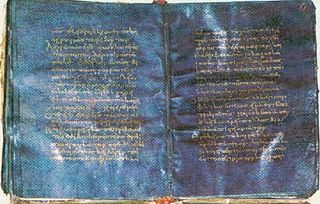| New Testament manuscript | |
 | |
| Text | Gospel of Luke |
|---|---|
| Date | 9th century |
| Script | Greek |
| Now at | Bavarian State Library |
| Size | 27.5 x 23 cm |
| Type | Byzantine text-type |
| Category | V |
Uncial 053 (in the Gregory-Aland numbering), A4 (Soden), is a Greek uncial manuscript of the New Testament, dated paleographically to the 9th century.

A manuscript was, traditionally, any document that is written by hand — or, once practical typewriters became available, typewritten — as opposed to being mechanically printed or reproduced in some indirect or automated way. More recently, the term has come to be understood to further include any written, typed, or word-processed copy of an author's work, as distinguished from its rendition as a printed version of the same. Before the arrival of printing, all documents and books were manuscripts. Manuscripts are not defined by their contents, which may combine writing with mathematical calculations, maps, explanatory figures or illustrations. Manuscripts may be in book form, scrolls or in codex format. Illuminated manuscripts are enriched with pictures, border decorations, elaborately embossed initial letters or full-page illustrations.

The New Testament is the second part of the Christian biblical canon, the first being the Old Testament. The New Testament discusses the teachings and person of Jesus, as well as events in first-century Christianity. Christians regard both the Old and New Testaments together as sacred scripture.

Palaeography (UK) or paleography is the study of ancient and historical handwriting. Included in the discipline is the practice of deciphering, reading, and dating historical manuscripts, and the cultural context of writing, including the methods with which writing and books were produced, and the history of scriptoria.







